Decoding Banque de France Serial Numbers
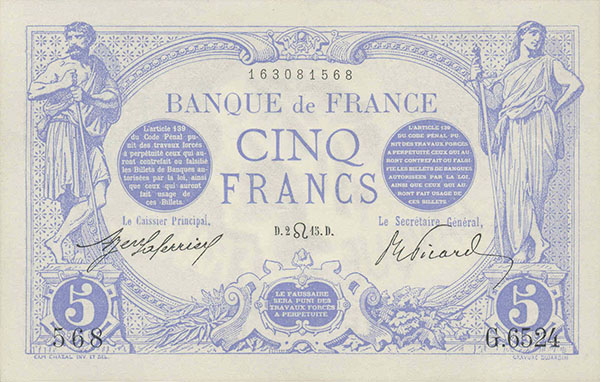
The numbering on Banque de France notes can be quite a mystery; curious folks want to know the details! Most of the good specialized catalogs will have descriptions going through the basics plus variants across the years. Let's look at the details.
Terms
Refer to the banknote image above for these terms.
The verification number (163081568), usually printed in the center of the note. This is a sequential serial number unique across the entire printing of the note.
A letter (G), at the front of each series, there are 25 letters used. "I" is skipped, and "W", used for replacement notes, appears at the end after "Z".
A series (G.6524), represents a group of 1000 notes.
The order or note number (568), is the number of this note within its series.
An alphabet is the set of series' containing all 25 letters, a group of 25,000 banknotes.
Numbering Sequence
In order then, the banknotes will be numbered as follows:
- The first note will have: verification number 000 000 001, series A.001, and order 001
- The second note will have: verification number 000 000 002, series A.001, and order 002
- The 999th note will have: verification number 000 000 999, series A.001, and order 999
- The 1000th note will have: verification number 000 001 000, series A.001, and order 000
- The 1001st note will have: verification number 000 001 001, series B.001, and order 001
We can decode the 5F bleu note as follows:
| There are 6523 complete alphabets ahead of T.130, so that's | 6523 alphabets × 25 series × 1000 notes |
163,075,000 |
| There are 6 series (A-F) of 1000 notes ahead of this, so that's | 6 series × 1000 notes |
+ 6,000 |
| This is the 568th note printed in this series | 568 notes | + 568 |
| The verification number is | = 163,081,568 |
The vast majority of Banque de France notes issued, whether for France itself or for the broad set of countries using its services, use the above numbering technique. The differences are in the count of notes in a series as described below, and a small set of one-off special cases.
100,000-Note Series
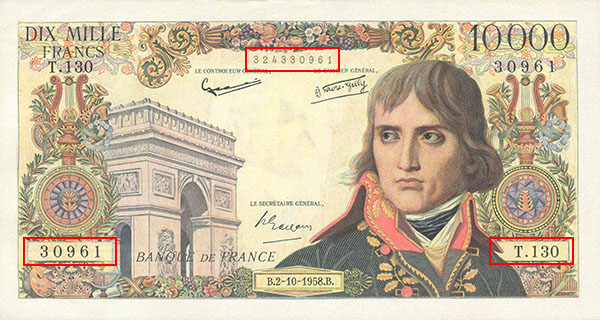
After 1940, the series counts are increased to 100,000 notes instead of 1,000. The most obvious change is that the order number now has 5 digits instead of 3. The overall numbering scheme is the same, it just changes to include 2,500,000 notes in an alphabet (25 × 100,000) instead of 25,000.
So for the Napoleon note, we can decode as follows
| There are 129 complete alphabets ahead of T.130, so that's | 129 alphabets × 25 series × 100,000 notes |
322,500,000 |
| There are 17 series (A-S) of 100,000 notes ahead of this, so that's | 17 series × 100,000 notes |
+ 1,700,000 |
| This is the 30961th note printed in this series | 30,961 notes | + 30,961 |
| The verification number is | = 324,230,961 |
Million-Note Series
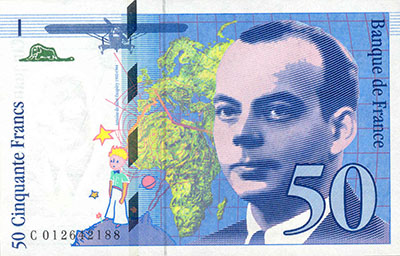
Beginning with the St. Exupéry series of 1992, numbering is presented with the series written directly in front of the note number, as a letter followed by a single 9-digit number, printed on the face and back of the notes. This numbering scheme though is identical to the previous method, except that now there are 1,000,000 notes in each series, 25,000,000 in an alphabet. The actual control number is not printed on the note, but can be calculated using the same math as previous methods.
Starting with A 000 000 001 (note the first series is numbered A 000), the notes were printed in groups of a million, at which point the letter is incremented. Once letter W is reached, the numbering restarts at A 001 000 000.
We can decode the St. Exupéry note as follows:
| There are 12 complete alphabets ahead of C012, so that's | 12 alphabets × 25 series × 1,000,000 notes |
300,000,000 |
| There are 2 series (A-B) of 1,000,000 notes ahead of this, so that's | 2 series × 1,000,000 notes |
+ 2,000,000 |
| This is the 642,188th note printed in this series | 642,188 notes | + 642,188 |
| The verification number is | = 302,642,188 |
One or Two-Digit Series Numbers
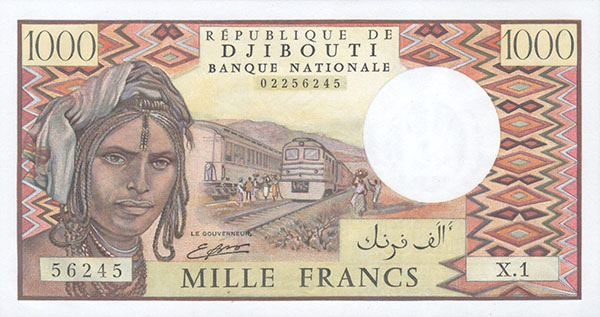
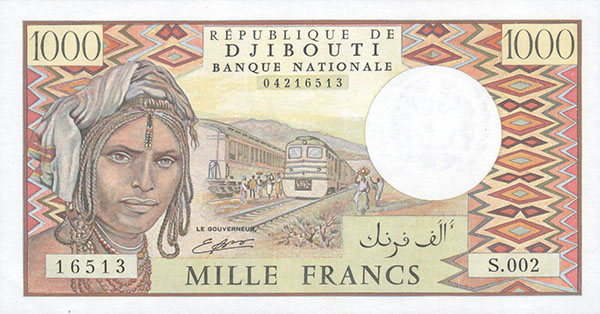
Often we see BdF banknotes with one or two-digit series numbers, sometimes changing to three-digit numbers in later versions of the note. These seem to all continue to stick with either 100,000-note or 1,000,000-note series counts, and simply have skipped the leading zeros on the early series (i.e. A.1 instead of A.001), perhaps having underestimated the number of banknotes that would eventually be produced.